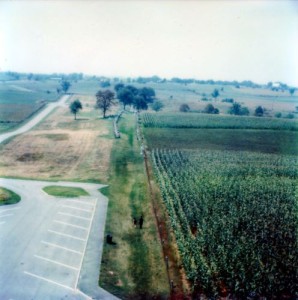I can recall four places in Maryland that we visited during our 1979 vacation. I also seem to recall spending the night in a Holiday Inn in Baltimore at some point before our 1988 return to Baltimore (more on that later), so this may have been the visit when we did that.
The four places I recall more-or-less clearly were the National Shrine of Elizabeth Ann Seton, the Barbara Fritchie House, the Antietam battlefield, and a cave. There is no indication in the photo album which cave we visited. It made an impression on me because the guy who gave us our tour looked to be only a couple of years older than I was, and he was *adorable.*
Elizabeth Seton was the first United-States-born saint (even though, technically, the United States didn’t exist at the time of her birth — she was born in 1774). When Seton’s husband was dying of tuberculosis, his doctor sent them to Italy, hoping the change of environment would be good for his health. It wasn’t, and he died. Seton converted to Roman Catholicism on the trip. As a widow, Seton needed a source of income, so upon her return home to New York City, she started a girls’ school, but this school failed because of anti-Catholic bias in New York.
Maryland was founded as a settlement for Roman Catholics. It is, after all, right there in the name. Seton was invited to move to Maryland and start a new school there, which she did. This was St. Joseph’s Academy and Free School, the first Roman Catholic school in the United States. These days, nearly all Roman Catholic churches have schools associated with them. This tradition started with Seton and St. Joseph’s Academy. Seton was beatified in 1963 and canonized in 1975.
The campus of the shrine is beautiful, though I don’t know if we spent much time in the basilica on the site or not.
We also went to the Barbara Fritchie House and Museum in Frederick Maryland. Fritchie is the subject of the Whittier poem about an elderly lady who interrupted the march of the Confederates by waving a Union flag at them during the Civil War. It is likely that this event never happened. Records show that Fritchie was sick in bed when the Confederates marched through Frederick and that the Confederates never marched down her street. And to top it all off, the house that Fritchie actually lived in was destroyed during a storm and the museum is in a replica built in 1927. It’s a lovely poem, however. Fritchie was also personal friends with Francis Scott Key, who wrote the poem which eventually became the national anthem of the United States. I seem to recall that the guest room was made up as if Key were staying there, though I may be remembering a different house entirely, or maybe I dreamed it. I have very vivid dreams.
We visited the Antietam battlefield because one of the tour guides, I think it was, or maybe it was someone who worked in one of the restaurants in Gettysburg, told us that Gettysburg was too touristy and that he always recommended that people go to Antietam instead. Now I’m wracking my brain. The place, which I’m now reasonably certain was a restaurant, had something to do with snipers. So after looking around, perhaps it was the Farnsworth House, which is a Civil War themed restaurant and the house was apparently a post for snipers. So that’s a good candidate. I wonder what would happen if I were to call them up and ask about a man in period soldier’s costume who told us to visit Antietam. . .
He was right, though. Antietam, site of the battle known both as “Antietam” and as “the Battle of Sharpsburg” was relatively untrammeled by tourists (see the empty parking lot in the photo below). The Battle of Antietam, which took place on September 17, 1862, was the first battle of the Civil War to take place in Union territory, and was the single bloodiest day of the war. The Union more or less won this battle, as they only lost 16% of their men, versus 27% for the Confederacy. “Only” 16%. Eesh. It was also “only” the fifth worst actual battle of the war.

It was very educational and the area where the battle took place was lovely, and is apparently becoming even nicer. The National Park Service is trying to restore the areas that were wooded at the time of the battle. Every fall and spring since 1995, they have had volunteers come in and plant over 18,000 trees in hopes of restoring the appearance of the area to how it looked in 1862. In the process, they hope to increase the ecological value of the land.
